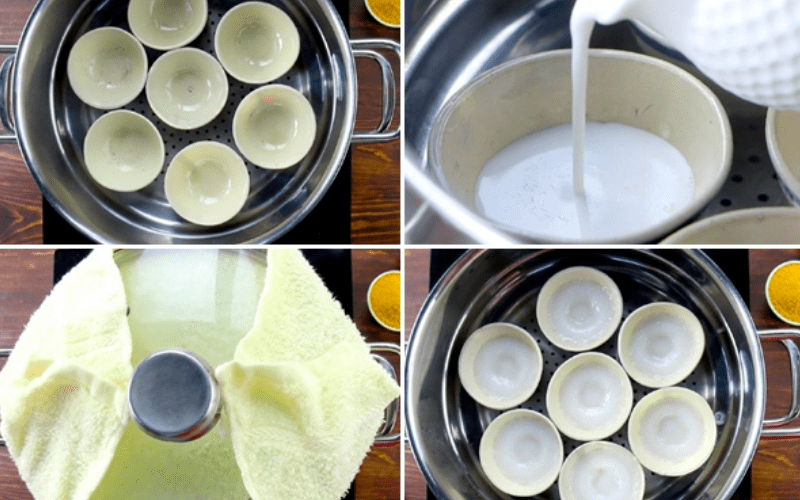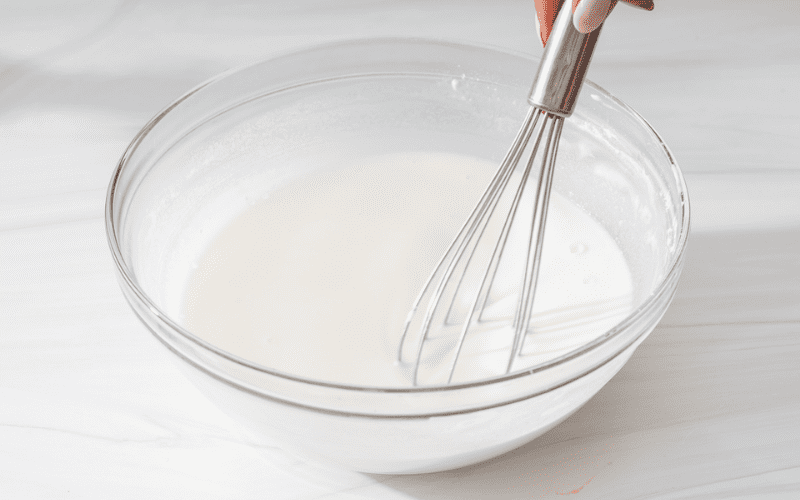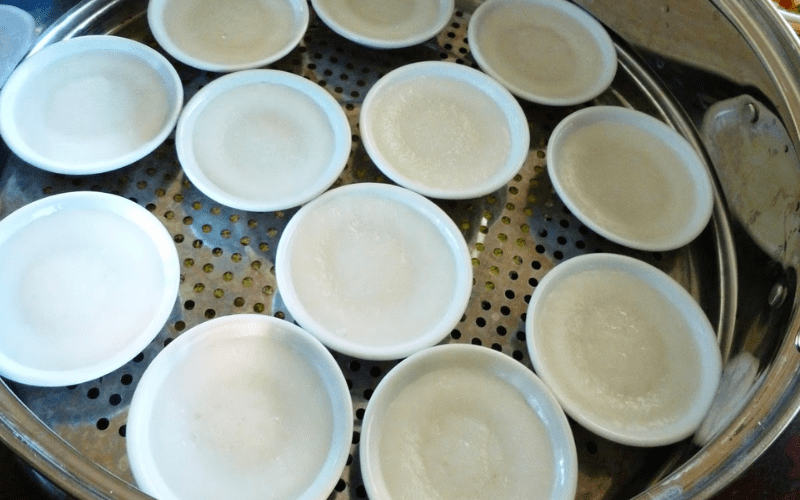Chinese rice pudding, also known as “Boot Jai Goh” is a delightful and cherished snack in Chinese cuisine. These small, round treats have a jelly-like texture that is slightly chewy and pleasantly sweet. They are made using a simple mixture of rice flour, tapioca starch, sugar, and water, highlighting the beauty of uncomplicated ingredients.
While the name might suggest a cake or pudding, Chinese rice pudding is more akin to a firm jelly. Traditionally, it is prepared in stoneware bowls, but you can use various containers to make them, giving you flexibility in the kitchen. The appeal of Chinese rice pudding lies in its humble yet enticing nature, proving that even the simplest of foods can bring immense joy.
What is Chinese rice pudding?
The name “Boot Jai Goh” refers to the stoneware bowls traditionally used to make them. However, they can be made in various containers, such as tart cups, foil tart cups, small bowls, or even a muffin tin. Despite their name, these rice puddings are not like conventional cakes or puddings. They have a firmer texture, similar to jelly but slightly denser.
Chinese rice puddings do not come in fruit flavors like traditional jelly. Instead, they offer a subtle sweetness that is enjoyed by many Chinese people. They are gluten-free and require only a few ingredients, showcasing the beauty of simple and humble foods in Chinese cuisine.
Traditional Chinese steamed rice pudding recipe
Cooking note
- Yield:
- Prep time: 15 minutes
- Cook time: 15 minutes
- Total time: 30 minutes.
- Course: Dessert
- Cuisine: Chinese
- Equipment: Measuring cups or bowls, a whisk or chopsticks, individual tart-sized dishes, a steamer, and toothpicks or a small spatula.
Ingredients
- 1/2 cup white sugar
- 2 cups water (for sugar solution)
- 1/2 cup glutinous rice flour
- 2 tablespoons tapioca starch
- Water (for rice flour slurry)
- Toppings (optional): red bean paste, lotus seed paste, fresh fruits, nuts, etc.
How to make Chinese rice pudding?

Make the sugar solution: In a measuring cup or bowl, dissolve the white sugar in hot water, stirring until the sugar is completely dissolved. Set aside.
Prepare the rice flour slurry: In a larger measuring cup or bowl with a spout, combine the glutinous rice flour and tapioca starch. Gradually add water while stirring with chopsticks or a whisk until the mixture becomes smooth and thickened, resembling milk in consistency.

Combine the sugar solution and rice flour slurry: Pour the sugar water into the rice flour slurry while continuously stirring with chopsticks or a whisk. Ensure that the liquids are well combined and there are no lumps.
Steam the cakes: Pour the rice flour mixture into individual dishes or bowls. Stir the mixture before pouring to avoid settling. Place the bowls in a steamer and steam over low to medium heat for about 15 minutes. The cakes will have a dimple in the middle and appear translucent when done.

Cool and serve: Remove the bowls from the steamer and let them cool completely at room temperature. As they cool, the cakes will turn white in color. Once cooled, you can add your desired toppings, such as red bean paste, lotus seed paste, fresh fruits, or nuts.
What if I make rice pudding with leftover Chinese rice?
Making leftover Chinese rice pudding is a great idea to repurpose the leftover rice into a delicious dessert. Here’s a simple method to make rice pudding using leftover Chinese rice:
Ingredients
- 2 cups leftover Chinese rice
- 2 cups milk
- 1/4 cup sugar (adjust to taste)
- 1/2 teaspoon vanilla extract
- Optional: Cinnamon, nutmeg, raisins, or other flavorings of your choice
Instructions
- In a saucepan, combine the leftover Chinese rice and milk. Heat the mixture over medium heat, stirring occasionally, until it starts to simmer.
- Reduce the heat to low and continue cooking the rice and milk mixture, stirring occasionally, for about 15-20 minutes or until the mixture thickens slightly.
- Add sugar and stir well to dissolve. Adjust the amount of sugar to your desired level of sweetness.
- Stir in vanilla extract and any additional flavorings or toppings you prefer, such as cinnamon, nutmeg, or raisins.
- Continue cooking the mixture for another 5-10 minutes, or until it reaches your desired consistency. If it becomes too thick, you can add a little more milk to thin it out.
- Remove the saucepan from heat and let the rice pudding cool for a few minutes.
- Serve the rice pudding warm or chilled, as per your preference. You can enjoy it as is or garnish it with additional toppings like fresh fruits, nuts, or a sprinkle of cinnamon.
How to remove Chinese rice pudding from the tart-sized dishes?
- Allow the rice pudding to cool completely in the dishes at room temperature. This will help the pudding set and firm up, making it easier to handle.
- Take a toothpick and run it along the edges of the rice pudding, separating it from the sides of the dish. Gently insert the toothpick between the pudding and the dish, making sure to go all the way around.
- Once you have loosened the pudding from the edges, carefully lift it up using the toothpick or a small spatula. Apply gentle pressure to prevent it from breaking.
- Slowly and steadily lift the rice pudding upward, supporting it with your fingers or a utensil if needed. Take care not to tilt or twist the dish too much, as it may cause the pudding to break apart.
- Once the rice pudding is completely lifted from the dish, transfer it to a serving plate or container of your choice.
How to store Chinese rice pudding?
Allow it to cool: Before storing the rice pudding, make sure it has cooled down to room temperature. This helps prevent condensation and maintains its texture.
Refrigeration: Transfer the rice pudding to an airtight container or cover the dish tightly with plastic wrap. Place it in the refrigerator for storage.
Use within a few days: Chinese rice pudding is best when consumed within 2-3 days of preparation. As time passes, the texture may change, and the flavor might diminish.
How to serve traditional Chinese rice pudding dessert?
Chinese rice pudding can be enjoyed both hot and cold, depending on personal preference. It is traditionally served warm or at room temperature, but some people also enjoy it chilled.
FAQs
What’s the difference between banh beo vs Chinese rice pudding?
Banh Beo is a Vietnamese dish made of small steamed rice cakes topped with various savory ingredients like dried shrimp, fried shallots, and fish sauce. It has a soft and slightly sticky texture, and it is typically enjoyed as a savory appetizer or snack.
On the other hand, Chinese rice pudding, or Boot Jai Goh, is a Chinese dessert made from a mixture of rice flour, tapioca starch, sugar, and water. It is steamed to create a jelly-like texture that is slightly chewy and mildly sweet. Chinese rice pudding is often served as a sweet treat or dessert.
Variations of Chinese rice pudding
Red Bean: Add sweetened red bean paste to the rice pudding mixture for a delightful twist.
Coconut: Incorporate coconut milk or shredded coconut to infuse the pudding with a tropical flavor.
Pandan: Infuse the rice pudding with pandan essence or extract for a fragrant and vibrant green hue.
Sesame: Stir in toasted sesame seeds or sesame paste for a nutty and aromatic flavor.
Conclusion
Chinese rice pudding, with its unique texture and subtle sweetness, is a delightful and traditional snack that offers a delightful culinary experience. Its simple ingredients and ease of preparation make it accessible to anyone who wants to explore the flavors of Chinese cuisine. Whether you are a fan of Asian desserts or simply curious to try something new, Chinese rice pudding is definitely worth a taste. Give it a try and indulge in this humble yet delicious treat that has been enjoyed by generations.
More related recipes you can try too